June 2010 archives
you are here [x]: Scarlet Star Studios > the Scarlet Letters > June 2010
<< before
April 2010
after >>
July 2010
June 11, 2010
mold design (part 2)
by sven at 7:00 am
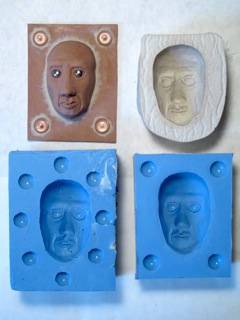
I want to do lipsynch using replacement faces. The idea is to have a set of ~12 masks that fit over a skull, which seats the puppet's eyes. Generic masks will be cast from resin, and then the mouths will be resculpted using either Super Sculpey or Magic Sculpt.
The resin will be cast from a 2-part silicone mold. The current iteration has several improvements over my last attempt:
- sculpt has better seal on mold bed
- to avoid entrapping bubbles, a "detail layer" of silicone is brushed onto the sculpt
- to conserve silicone, I've made a plaster "mother mold"
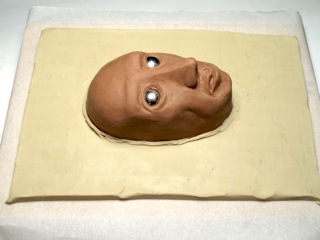
Fig.1: For my last mold-making attempt, the sculpt and mold keys were seated on a piece of wax paper. This go around, I decided to seat the sculpt on a bed of clay, to get a better seal.
I tried using Kleen Klay. However, I felt this material was much too soft.
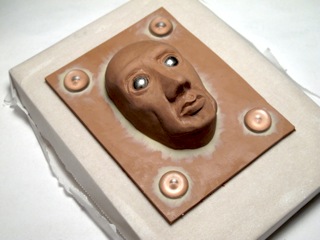
Fig.2: For my next try, I lay down a bed of Chavant NSP medium, which is much firmer. I could then use Kleen Klay as a sealant without marring either the sculpt or the bed.
An incidental note about nomenclature… Both Kleen Klay and Chavant are types of oil-based modeling clay. I've been wondering for a while what the general term is for this stuff: "plasticene" or "plastilina"? Turns out the answer is neither. Both those words are genericized brand names — like how "Kleenex" is often used to refer to facial tissue in general. (reference)
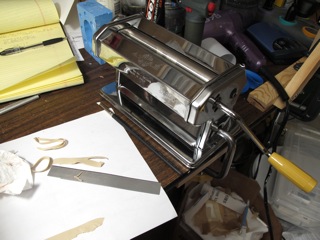
Fig.3: How did I get the Chavant to be so nice and flat? I sent it through a pasta roller.
Polymer clay hardly sticks at all; Chavant leaves a bit of a film on the roller, which causes it to begin sticking to itself. I fixed a few minor defects in the surface by using a brayer.
(I also tried using a butane micro-torch to melt the surface of the clay… But then I had to wait a long while for it to cool again. More trouble than it's worth — wouldn't do that again.)
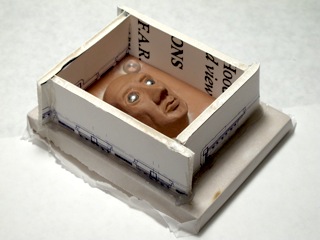
Fig.4: As with my last mold, the walls are made of 1.5" wide strips of repurposed foam core. I didn't cut the walls as long as before, though. Sealing the walls with hot glue was easier if the walls didn't hang out over the edges of the wooden base.
A note on cutting foamcore: box cutters work better than X-acto blades. Because the box cutter has a wider blade, it's more inclined to travel in a straight line.
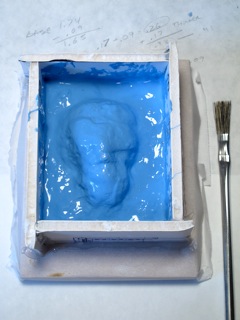
Fig.5: I mixed up a small batch of silicone base, catalyst, and thinner. I applied the silicone mix to the sculpt using a disposable "acid brush." After watching a few videos online, I picked up that the trick to doing a "detail layer" like this is that you dab with the ends of the bristles, rather than painting with strokes.
I baked the silicone at 170 F for about 90 minutes to cure the silicone extra fast — then I put it in the freezer to re-congeal the clay. The oven temperature was low enough that neither the hot glue nor the foamcore seem to have melted. Happily, the silicone also seems to cure faster than the clay can liquify.
Even so, I kept the kitchen door wide open and stayed out of the room during this part of the process. I want to minimize the number of things that can possibly release fumes when warmed. I was surprised to discover that MDF gets smelly when heated. For the second half of the mold, I made a cardboard tray, which was better.
I believe I have a better alternative to using foam core for mold walls, too… The next time I make a mold, the walls will be made out of Legos!
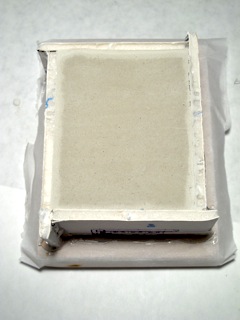
Fig.6: The cured silicone "detail layer" is fairly floppy. To give it some support, I created a "mother mold" by pouring UltraCal 30 plaster into the box.
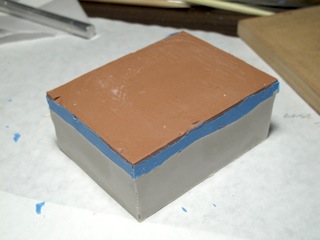
Fig.7: Here's the mold-in-progress after I've removed the foamcore walls. I really dig the layers of different colors!
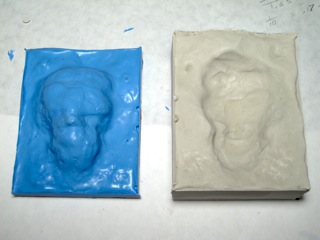
Fig.8: The silicone pulls away from the plaster effortlessly. The mother mold bears the lumpy impression of the silicone. The lumpiness is enough to register the two parts together.
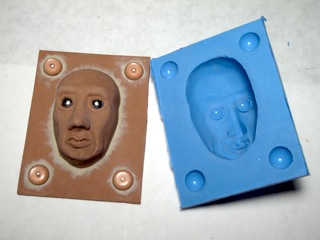
Fig.9: The sculpt came away from the silicone cleanly, and the detail layer has no bubbles. Awesome!
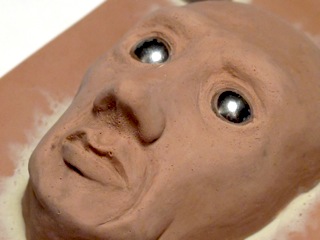
Fig.10: It's not a major flaw, but I was dismayed to discover that the acid brush left stippling in the sculpt. Apparently it's important to use a brush with really soft bristles. (Freezing the sculpt could also help protect it against brush marks.)
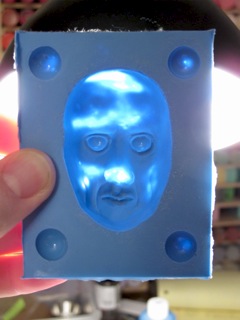
Fig.11: When I held the silicone up to a light, I discovered that there were several thin spots. The mold is useable — but I would have been smart to go in and apply a second layer of silicone on high areas of the sculpt to ensure adequate thickness.
[Now that I've done some castings in this mold, I'm noticing that the mold buckles a little at the thin spots… Acceptable but avoidable imperfections.]
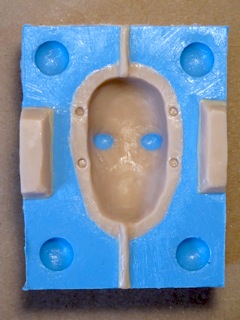
Fig.12: This is 2-part mold. Side A is done — now to make side B.
I sculpted what will be the interior side of the puppet mask using Super Sculpey. I chose it largely for where it falls on the soft/firm continuum… But I'm not so sure it was the best choice. When I put it in the oven, it didn't get fully hard — but it did cure enough so that I won't be able to re-use the material.
The vertical rods at the top and bottom are to be sprues, where excess resin can escape. If this were a simple mask, just one sprue would be necessary… But I'm actually going to wind up doing the forehead and lower face as separate pieces. More about that later!
The trapezoidal blocks on either side will create open spaces that make it easier to pry the two mold halves apart. The four little dots will hold 1/8"x1/16" magnets, that allow me to attach the mask to the back of the puppet's head.
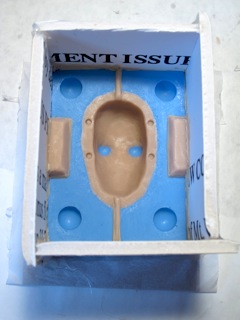
Fig.13: Once again I build a mold box. This time the walls are 3" tall. Cracks are sealed up with that ultra-soft Kleen Klay.
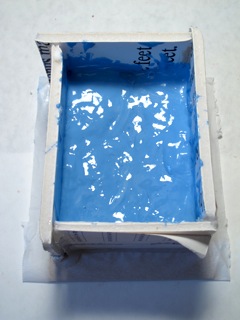
Fig.14: Again, brushing in a layer of silicone, using a dabbing motion to avoid creating bubbles. This time I used a soft-bristled art brush. Silicone destroys the brush — but I found ones being sold for 25¢ apiece at I've Been Framed (4950 SE Foster Rd), so not too big a loss.
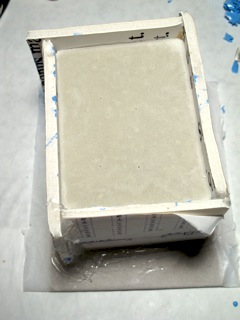
Fig.15: This second layer of silicone also needs a plaster mother mold.
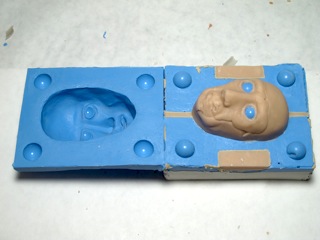
Fig.16: Opening the completed mold, I found that the Super Sculpey got partially cured in the oven. No big loss… But it wouldn't have been an issue if I were more patient and let the silicone cure at room temp for 6 hours.
Hypothetically, you could press Sculpey into the silicone mold and then bake it. Silicone tends to be quite heat resistant, so I'm pretty sure it could keep its integrity at the 275 F required for a full polymer clay cure… But I see no advantage at present. (Perhaps a less toxic solution than resin?)
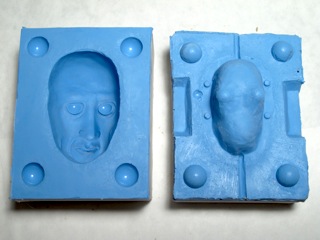
Fig.17: OK! Here's the completed mold all cleaned up. Time to pour some resin!
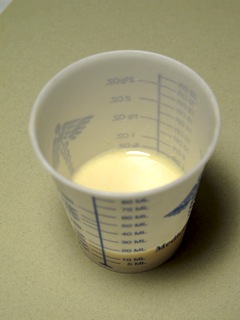
Fig.18: The resin I'm using has a 1:1 ratio of part A & part B, measured by volume. I got these paper measuring cups at the same store where I bought the resin — TAP Plastics. Using 15 ml of each component is about enough to make a full mask with minimal overflow.
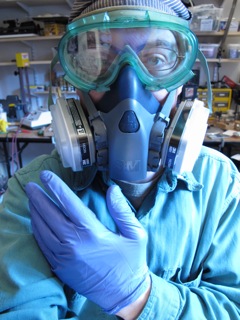
Fig.19: Safety first! When working with resin, you want impermeable gloves. I've got nitrile — I'm looking into butyl, which may have reusable options. Latex will not do — resin penetrates it.
Splash goggles. Long-sleeved shirt. And a respirator that has cartridges rated for organic vapors. I recommend 3M brand respirators. They're comfortable for day-long use — and these things only protect you if you actually wear them. If you go with 3M, the model no. 6001 cartridges are what you want.
* (Firefly reference. Shiny, eh?)
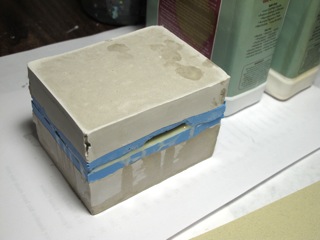
Fig.20: To get a good casting, there needs to be a little bit of overflow, which exits the mold through the sprues. For my first few castings, I laid down scrap paper on my desk to catch the overflow. Later on I refined my work area, covering a steel tray with sheets of wax paper.
Giving the resin 60 minutes to cure is ideal — but I found I could get away with demolding at 30 minutes. With about 15 minutes to clean up the mold and make another batch of resin, it looks like I can make one part approximately every 45 minutes.
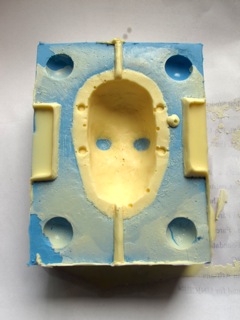
Fig.21: Having thin layers of silicone that fit inside plaster mother molds makes it very easy to remove the resin castings. They just pop out. The flashing can be snapped off, or cleaned off more carefully with an X-acto knife.
However, I do recommend waiting a while before carving the resin. When you first de-mold, the resin is still soft, and it will likely distort from the pressure of your grip.
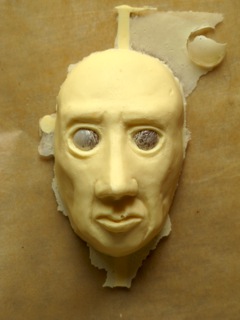
Fig.22: After doing a few pours, I've begun to recognize the areas that are most likely to capture air bubbles… The lips, the nose. So long as I pour carefully, it's not an issue. And if I'm nervous, I can just gently poke around in the area with a toothpick to break any hidden bubbles.
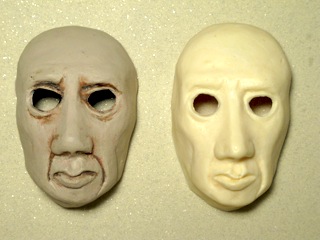
Fig.23: Comparing the Sculpey and Resin masks, you have to remember that the sculpt had to be modified before making the new mold… And the Sculpey's been painted, with makes it look better at this point.
The process of making a 2-part silicone mold is a great deal more time consuming than a simple plaster press mold. However, I feel much more confident that the masks I make will be identical in shape, and the mold is surviving the wear and tear of castings much better. So, in terms of my goals, I'd say the project was a success.
Next: Making a batch of generic masks and modifying them with different mouth shapes. Sorry folks, this may take a while…
posted by sven | permalink | categories: stopmo
June 10, 2010
mold design (part 1)
by sven at 4:14 pm
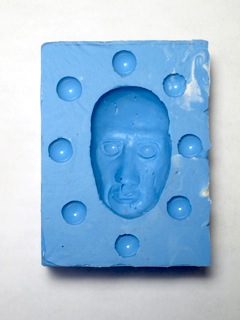
I'm back at work on creating replacement faces for the "Howard" puppet.
I've abandoned pressing Super Sculpey into an UltraCal 30 plaster mold. Getting the Sculpey out of the mold without distortion wasn't working out so well. And the plaster mold was beginning to lose fine detail.
Oh well. The press mold idea was always intended as a stepping stone on my way to something better: making resin castings from a silicone mold.
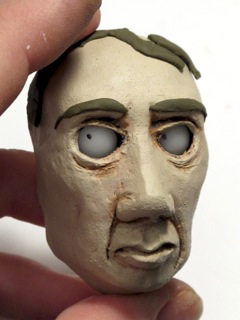
Fig.1: Here's a reminder of what Howard looked like when the Sculpey casting was fully painted. Doing resin castings from a silicone mold should allow me to replicate the original sculpt even more precisely.
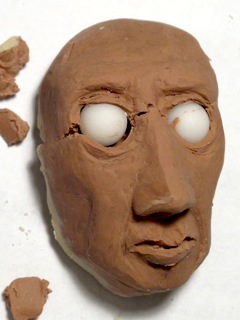
Fig.2: The original Howard sculpt was made from Chavant NSP medium. It cracked when coming out of the plaster mold, but was otherwise in pretty good condition. Before making a new silicone mold, some repair and resculpting is called for.
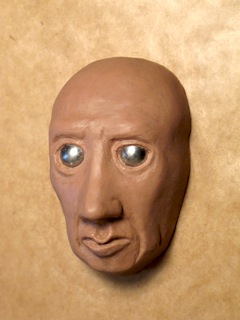
Fig.3: The newly repaired sculpt isn't exactly the same as the original, but it's very close. There were a few areas that I reworked... And I also made the surface much more smooth.
I tried a trick I read about on pro sculptor Dave Pressler's blog, where you use a butane torch to melt the surface of the clay. Jury's still out on that one. [Note: I switched out the acetal plastic eyes for 3/8" stainless steel balls to fire-proof the sculpt.]
I also tried a trick I learned from a sculptor at Bent, where you use Brylcreem as a solvent. I like this one — it's nice that the solvent is a paste, rather than a fluid like alcohol or citrisolve. It's easier to control, and gives off less fumes.
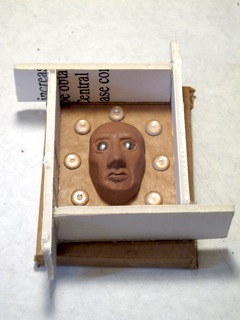
Fig.4: The mold box was made from pieces of foam core that I got cheap from Scrap. Notice the way that the walls overlap one another — that makes it easy to get the things to line up well.
The sculpt is sitting on a piece of MDF (a type of particleboard) that's been wrapped in wax paper. The mold walls are set in place using hot glue. If the walls hang over the edges of the base, be sure to hot glue their undersides too, to avoid leaks there.
Acrylic hemispheres where taped into the mold to a act as mold keys.
Fig.5: I was dismayed to discover that my silicone is labeled as having a 6 month shelf life. I've had this current supply sitting around for 2 or 3 years.
The silicone base seemed even thicker than usual, and I think the working time was reduced. My first batch clotted up before I could do anything with it. A shame! Silicone is one of the more expensive materials in my workshop. :(
Fig.6: I ran a second batch of silicone, this time mixing it with silicone thinner. I was able to get a useable material this way — but it still wasn't thin enough to pour.
A big problem with silicone is that it traps bubbles. The pro solution is to put the material into a degasser (a vacuum chamber), which causes the bubbles to explode. Unfortunately, degassers begin at about $300.
However, there's a poor man's solution that I learned about from this excellent TAP Plastics video, where you cut a hole in your mixing cup… If you let the silicone pour from 3 feet up, it turns into a string on the way down, which breaks the bubbles. Pretty cool.
But, since my silicone was still too thick to pour, I just had to glop it into the mold as best as a could… Knowing full well It probably wouldn't result in a useable mold.
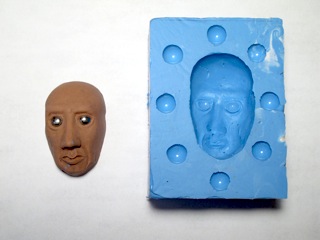
Fig.7: There are two kinds of catalyst you can use with this silicone: fast cure and regular cure. Fast cure takes 6 hours, regular takes 16. I HATE waiting between steps — so I went with fast cure.
Here's another really excellent trick. Stick your silicone in the oven at its lowest setting. (On mine, that's 170 F.) Curing is a chemical reaction, and chemical reactions can almost always be speeded up or slowed down by heating/cooling. By using the oven, I was able to get the silicone adequately cured in only 90 minutes.
But wait! As I learned the hard way on my last silicone mold, if you de-mold at this point, the Chavant will still be in a melted state. Take it out, and the sculpt is ruined — and it leaves a clay residue in the mold.
This time I was smart and put the mold in the freezer for a while before taking out the sculpt. Worked like a charm! The sculpt came out clean and undamaged!
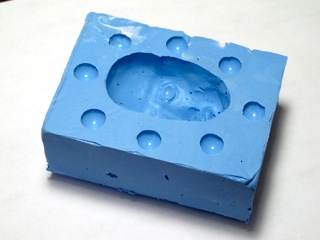
Fig.8: As I feared, the silicone trapped lots of little bubbles. It looks like swiss cheese in there. Silicone also seeped underneath the mold keys an sculpt a little, creating a slight undercut, which is no good.
The mold is unusable. However, during the process of making this mold I had a little revelation.
I've always thought of mold-making as a matter of selecting one of the standard mold-making methods, and following it to the T. Now I realize that mold-making is actually a matter of design. Each mold you make is going to be somewhat unique, and requires an active application of intelligence and creativity.
With that insight in mind, I've decided to get good at making molds… Viewing mold-making as an artform unto itself.
This failure helped me come up with lots of improvements to build into the next mold design… Which is the subject of my next post.
posted by sven | permalink | categories: stopmo
June 2, 2010
mutate
by sven at 12:15 pm
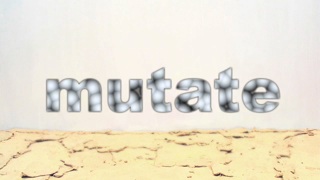
Here's the new film: Mutate.
It was intended to be improv... But then the shape of a story emerged and I just had to see it out.
The project took about 75 hours to finish, over two non-consecutive weeks. Roughly:
- 38 hrs animating
- 26 hrs sound + editing
- 11 hrs set-up + clean up + learning Dragon
I prefer the look of puppets to clay — but clay does have its virtues. I had a blast sculpting those tongue and tentacle shapes. :)
posted by sven | permalink | categories: stopmo
June 1, 2010
stopmo in progress: mutate
by sven at 10:38 am
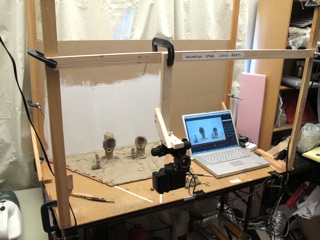
I'm almost done with a new stopmo film, "mutate." Just finishing up adding sound cues.
It can take months to to fabricate armatures, puppets, and sets for a polished stopmo film. I think it's important to keep your animator muscles warm in the meantime. So this project was a "quick" improv. Like going out for a jog around the block while in training for the marathon.
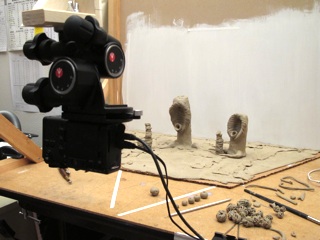
Short jogs are a good way to try out new methods. During this project, a number of tech issues have taken the next evolutionary step forward:
Framegrabber: Dragon
I've finally purchased Dragon Stop Motion — and it's been a joy to work with. Head and toes above FrameThief, iStopMotion, and AnimAideXT.
Hi Def
I'm shooting Blu-Ray standard Hi Def (1920x1080 pixels) using my old Canon PowerShot G5 digital still camera. This is my first time using the 16:9 aspect ratio, which has (finally) emerged as the unified standard for both film and TV. None of the computers at our house can play HD files — but you can always shrink the master file down. What I'm doing is future-proofing my films so that they still have some value 5 years from now.
Camera mount: Manfrotto
This is my first time using a Manfrotto 410 geared head to mount the camera. I'm a little troubled that you can't lock it into position... But its precision has allowed perfect recovery from a significant camera bump.
Shooting upside down
While shooting her film "Little Theatres," Stephanie Dudley has hung her camera upside down to get some tricky shots. An epiphany! There's no camera tripod to kick when the camera hangs from above! So much elbow room is freed up, I'm only ever going to use a tripod again if I absolutely must. [Incidentally, Dragon, makes flipping frames a breeze.]
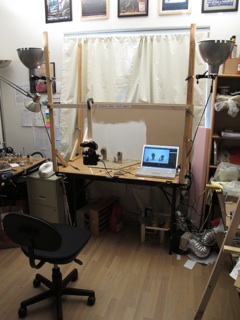
I should comment on a few of the tricks I'm repeating from previous projects...
Modular stage design
Pros build their animation tables from the ground up. For my home set-up, it's worked well to build up from a 2'x4' folding table. I've got several reusable lighting pylons that attach to the table with C-clamps. (You can never have too many C-clamps!) For this project, there were no tie-downs — so I didn't need a raised stage — I could work directly on the table top. But for future projects, I can quickly set up a raised stage by clamping horizontal struts onto the pylons, which then support the stage floor. I'm really happy with this fast, versatile approach.
Field of vision
After locking the camera in place, I find it very useful to tape off the boundaries of what the lens can see. This avoids wasting fabrication time on stuff that won't be in frame.
[I've gone a step farther, too. I know that the G5's maximum angle of view is 54.4º. After doing some basic trig, I realized this means the distance of the camera from the backdrop is very nearly equal to the width of the backdrop. This 1:1 ratio is extremely useful for estimating how much studio space I need for different set designs. Anyone interested in learning more about that math?]
Lighting
I've got two GE Crystal Clear 200 watt bulbs pointed at the ceiling. Each puts out 3980 lumens — which is massive. The bulbs are commonly available at department stores and Home Depot. Bouncing the light off the ceiling approximates noontime on a slightly overcast day. Bouncing diffuses the light, to avoid any hard shadows. Not very dramatic — but handy if you just need a flat, cartoony look.
OK, that's enough for now. I hope to have the finished film posted sometime this week.